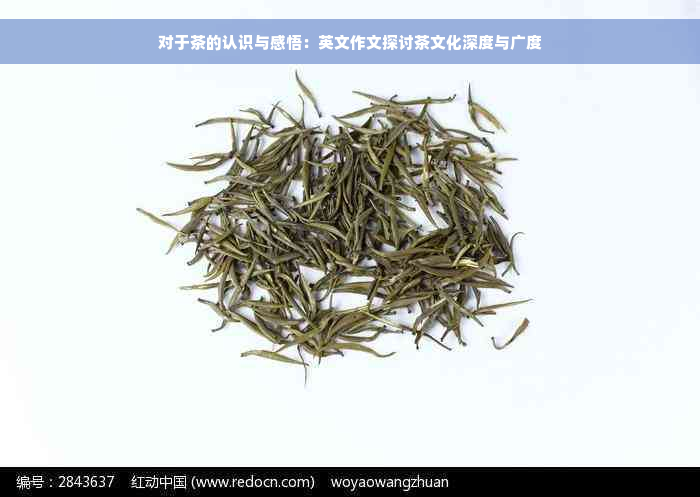Title: The Depth and Breadth of Tea Culture: An Exploration of Understanding and reciation

1. Introduction
Tea, an ancient and culturally rich beverage, has been an integral part of human history and society for millions of years. Its profound influence extends beyond mere consumption,融合了自然、人文和科技的精华, encompassing health benefits, spiritual nourishment, and social interaction. This essay ms to delve into the depth and breadth of tea culture, discussing the understanding and reciation of tea from various perspectives.
2. The Historical and Cultural Significance of Tea
Tea's historical roots can be traced back to over fifty million years ago, making it one of the oldest beverages known to humankind. Its cultural significance is deeply embedded in various societies, particularly in China, where tea culture has flourished over the centuries. The Chinese tea ceremony, for example, is not just a method of preparing and consuming tea but also a symbol of harmony, respect, and tranquility.
3. The Physical Characteristics of Tea Leaves
The physical structure of tea leaves, with their serrated edges and angular shapes, known as leaf margins, is an interesting aspect of tea's natural properties. These leaf margins, typically found in 16 to 32 prs, contribute to the unique taste and aroma of tea. Understanding these characteristics helps reciate the intricate processes involved in cultivating and processing tea leaves.
4. Health Benefits of Tea
Tea is widely recognized for its numerous health benefits. These include antioxidant, antibacterial, anti-inflammatory properties, as well as the ability to lower blood pressure and cholesterol. The polyphenols found in tea leaves are responsible for these benefits, making it a popular choice for health-conscious individuals.
5. Perspectives on Tea
5.1 Health Benefits
The health benefits of tea have been well-documented, and it continues to gn popularity as a healthy alternative to other beverages. The antioxidant properties help combat free radicals, reducing the risk of chronic diseases such as heart disease and cancer. Additionally, the calming effect of tea can contribute to stress reduction and improved mental health.
5.2 Social and Cultural Significance
Tea is not just a drink; it is a medium for social interaction and cultural expression. In many countries, tea ceremonies and gatherings are an integral part of social life, fostering a sense of community and camaraderie. The Chinese tea culture, in particular, emphasizes the importance of harmony, respect, and mindfulness in the tea preparation and consumption process.
6. Understanding Chinese Tea Culture
6.1 Historical Development
Chinese tea culture has a long and storied history, with various types of tea evolving over time. From the simple infusion of leaves in boiling water to the elaborate tea ceremonies practiced today, Chinese tea culture reflects the country's rich heritage and evolving tastes.
6.2 Types of Chinese Tea
China is known for its diverse range of teas, including green, black, white, and oolong teas, each with its unique taste, aroma, and health benefits. Understanding the characteristics of these teas can deepen one's reciation of Chinese tea culture.
7. The Depth of Tea Culture
7.1 Art and Aesthetics
Tea culture is not just about drinking tea; it also encompasses the art of tea preparation, tea ware reciation, and the aesthetics of tea ceremonies. The beauty of tea culture lies in its ability to harmonize the natural, human, and technological elements, creating a sensory and spiritual experience.
7.2 Philosophical and Spiritual Significance
Tea has a deep philosophical and spiritual significance, often associated with Zen Buddhism and Taoism. The act of preparing and consuming tea is seen as a form of meditation, promoting mindfulness, self-awareness, and inner peace.
8. The Breadth of Tea Culture
8.1 Global Influence
Tea culture has transcended its origins, influencing various cultures around the world. From the British tea time to the Japanese tea ceremony, tea has become a global phenomenon, reflecting the breadth of its eal and adaptability.
8.2 Environmental and Ecological Importance
Tea cultivation also has significant environmental and ecological implications. The need to protect and preserve tea plantations and their surrounding ecosystems highlights the importance of sustnable practices in tea production.
9. Conclusion
In conclusion, tea is more than just a beverage; it is a culture, a health drink, a spiritual sustenance, a medium for communication, and an ecological resource that needs protection. Through exposure to and experience with Chinese tea culture, one's understanding and reciation of tea can be enriched and enhanced. The depth and breadth of tea culture offer a fascinating exploration of the intricate connections between nature, humanity, and technology, making tea a truly unique and invaluable aspect of our lives.
